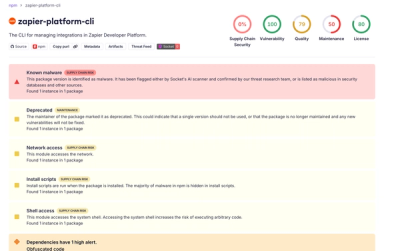
Research
/Security News
Shai Hulud Strikes Again (v2)
Another wave of Shai-Hulud campaign has hit npm with more than 500 packages and 700+ versions affected.
babel-plugin-inline-react-svg
Advanced tools
A babel plugin that optimizes and inlines SVGs for your react components.
Transforms imports to SVG files into React Components, and optimizes the SVGs with SVGO.
For example, the following code...
import React from 'react';
import CloseSVG from './close.svg';
const MyComponent = () => <CloseSVG />;
will be transformed into...
import React from 'react';
const CloseSVG = () => <svg>{/* ... */}</svg>;
const MyComponent = () => <CloseSVG />;
npm install --save-dev babel-plugin-inline-react-svg
.babelrc (Recommended).babelrc
{
"plugins": [
"inline-react-svg"
]
}
ignorePattern - A pattern that imports will be tested against to selectively ignore imports.caseSensitive - A boolean value that if true will require file paths to match with case-sensitivity. Useful to ensure consistent behavior if working on both a case-sensitive operating system like Linux and a case-insensitive one like OS X or Windows.svgo - svgo options (false to disable). Example:{
"plugins": [
[
"inline-react-svg",
{
"svgo": {
"plugins": [
{
"name": "removeAttrs",
"params": { "attrs": "(data-name)" }
},
"cleanupIDs"
]
}
}
]
]
}
Note: If plugins field is specified the default enabled svgo plugins will be overrided. Alternatively, if your Babel config is in JavaScript, the default list of plugins can be extended by making use of the extendDefaultPlugins utility provided by svgo.
const { extendDefaultPlugins } = require('svgo');
module.exports = {
plugins: [
[
'inline-react-svg',
{
svgo: {
plugins: extendDefaultPlugins([
{
name: 'removeAttrs',
params: { attrs: '(data-name)' }
},
'cleanupIDs',
])
}
}
]
]
}
$ babel --plugins inline-react-svg script.js
require('@babel/core').transform('code', {
plugins: [
['inline-react-svg', { filename: 'filename representing the code' }],
]
}) // => { code, map, ast };
Inspired by and code foundation provided by react-svg-loader.
FAQs
A babel plugin that optimizes and inlines SVGs for your react components.
We found that babel-plugin-inline-react-svg demonstrated a not healthy version release cadence and project activity because the last version was released a year ago. It has 6 open source maintainers collaborating on the project.
Did you know?

Socket for GitHub automatically highlights issues in each pull request and monitors the health of all your open source dependencies. Discover the contents of your packages and block harmful activity before you install or update your dependencies.

Research
/Security News
Another wave of Shai-Hulud campaign has hit npm with more than 500 packages and 700+ versions affected.

Product
Add real-time Socket webhook events to your workflows to automatically receive software supply chain alert changes in real time.

Security News
ENISA has become a CVE Program Root, giving the EU a central authority for coordinating vulnerability reporting, disclosure, and cross-border response.